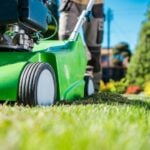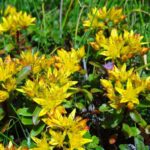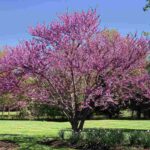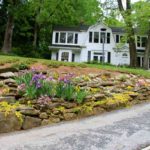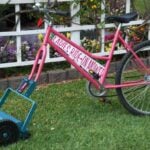
From the Varsity sign to the Olympic flame to Bank of America Plaza, Atlanta’s city skyline offers gorgeous views of famous, towering buildings. But towering trees? They provide even more than beauty; they deliver environmental benefits to this area, as well.
Of course, it doesn’t get any more Georgia than the peach tree, but here’s a look at how you can implement various other trees in the landscape design of your ATL home.
1. Give Shade with Canopy Trees
One reason to plant trees in your yard is to help reduce cooling costs. This is especially important if you live in the heart of Atlanta, where buildings and hard surfaces create what’s known as “heat islands.” These heat islands can force temperatures up to 22 degrees hotter than in rural areas.
Trees Atlanta will plant a maximum of three trees in your front yard to combat heat islands at no charge. Deciduous trees prevent the sun from overheating your house from spring through late summer and allow sunlight to filter in and add warmth in fall and winter.
Consider the following canopy trees that grow best in Hotlanta’s climate and soil:
- Bald cypress (taxodium distichum)
- Crepe myrtle (Lagerstroemia indica x fauriei)
- Chinese dogwood (cornus kousa)
- River birch trees (betula nigra)
- Trident maple tree (acer buergerianum)
- Eastern redbuds (Cercis canadensis)
- Loblolly pine (pinus taeda)
- Red maple (acer rubrum)
- Weeping willow (salix babylonica)
- various oaks
2. Boost Curb Appeal with Trees in the Front Yard
Beautifying your front yard can be done with flowering trees, ornamental trees, evergreen trees, and trees that bring fall color to your yard. These trees also help increase biodiversity by providing shelter and food for wildlife.
Great options for flowering trees in large yards
- Southern magnolia
- Tulip poplar
- American linden
- Cherry blossom trees
Evergreen trees, including conifers, for large yards
- Atlas cedar
- Camphor tree
- Japanese crytomeria
- Leyland cypress
Best trees for fall color in large yards
- Red maple
- Sugar maple
- Gingko biloba
- Sweet gum
Best flowering trees for small yards
- Flowering dogwood
- Flowering crabapple
- Eastern redbud
- American yellowwood
Evergreen trees, including conifers, for small yards
- Pindo palm
- Loquat
- Holly trees
- Virginia pine
Best small trees for fall color
- Washington Hawthorne
- Sourwood
- Chinese pistache
- Smoke tree
3. Grow Trees for Food
Often used as focal points in landscape and garden designs, nut and fruit trees bring an added bonus to your property — homegrown food. A few selections your taste buds and outdoor spaces may fancy:
- peach trees
- downy serviceberry
- American persimmon
- crabapple trees
- fig trees
- kiwi trees
- pear trees
- plum trees
- elderberry trees
- chestnut trees
- black walnut trees
- pecan trees
Other trees that bear fruit and nuts only birds and other wildlife eat are good to plant, too. Take a look at these options:
- Devil’s walkingstick
- fringe tree
- blackgum and sweetgum trees
- overcup oak
- sassafras tree
4. Choose Trees that Will Create Privacy
Some trees can pull double duty by adding beauty, providing shade, serving as a focal point, or bearing food and acting as living fencing. If you’re looking for privacy trees to create a barrier between neighboring houses, try these options, each of which have a medium to fast growth rate:
- Virginia pine
- dawn redwood
- White pine
- Canadian hemlock
- Deodar cedar
- Leyland cypress
- Camphor tree
- Japanese crytomeria
- Loblolly pine
5. Plant the Right Trees in the Right Place
Be mindful of where you plant your trees. Doing so will help cut down on maintenance issues, total expenses, and can increase a tree’s life span, according to Trees Atlanta.
Trees need plenty of space to expand their canopies and roots, so avoid planting too close to your home’s foundation, utility lines, driveway, walkways, and other hardscapes. You also want to avoid planting 30-foot trees underneath power lines. Larger trees will also block lines of sight for drivers and pedestrians.
When adding new trees to your landscape design, take care to consider the mature trees already on your lot, as well. One way to do this is to group new trees with the older ones.
“Trees planted in groups have been shown to perform better for environmental impact, tree health, and survival from challenging weather incidents,” say the experts at Trees Atlanta.
Other things to consider when planting trees: which varieties grow best in full sun or partial shade.
Landscaping With Trees in Atlanta: Other Things to Know
What are the best trees to grow in Atlanta?
Situated in Plant Hardiness Zones 7b and 8a, Atlanta is known for its hot summers and semi-cold winters. In addition to the selections we’ve already discussed, such as crepe myrtles, kousa dogwoods, and river birch trees, other landscape trees suitable for this environment include:
- American hornbeams
- Japanese maples
- Mockernut hickories
- Vernal witch hazel trees
- Umbrella magnolias
- Cherrybark oaks
- Pond cypresses
- Winged elms
- Persian ironwood and these top picks, too.
The fastest-growing shade trees to plant in Atlanta
For quick shade, choose deciduous trees with a fast growth rate. A few of them are:
- Sugar maples
- Yellow poplars
- American sycamores
- London planettrees
- Water oaks
- Nuttall oaks
- True Chinese elms
- Athena lacebark elms
- Allee lacebark elms
- Green vase Japanese zelkova
When to Call a Landscaping Professional
Knowledge is power, but absorbing a lot of it all at once can also be super overwhelming. Speak with an Atlanta landscape architect before hitting up your local garden center. They’ll help you narrow down the best, and most beautiful trees for your outdoor space.
Then, you can choose to go forward and DIY your tree planting or keep the pros on board to do it for you. Soon, you’ll be basking in the serenity of your very own natural space — no fighting traffic to get to Piedmont Park necessary.
Main Photo Credit: Pixabay
